MultiDiv Blogs (2021)
Libraries are made for everyone: Does your library provide for you?
Sophie Frankpitt, Vincci Chung, Borbála Sallai, Olivia Brewer and Aava Gourlay
Did you know that your public library acts as a community centre? This is because it brings people together from many different cultural and linguistic backgrounds. Or at least, it does in theory.
In this study, we examined three libraries to see whether this is actually the case. We focused on how Chinese speaking communities were represented in three public libraries: Coventry Central Library and Bristol Central Library in the UK, and Knox Library in Melbourne, Australia. According to the 2011 UK census and the 2016 Australian census, there is a large Chinese-speaking proportion of the population in Knox, Coventry and Bristol, which made this minority group highly interesting to us.
Our project was guided by a specific focus on stock. We paid close attention to the presence of different languages to ultimately see if the libraries provide for the Chinese-speaking community. We asked the question: How are Knox Library, Coventry Library and Bristol Library using stock—through display, language choice, and stock titles—to provide for the Chinese-speaking community?
Why libraries?
Lots of studies have looked at public libraries, their role in a community, as well as ways to enhance and improve their services. We took inspiration from these previous works and applied it to our own research.
The State Library of New South Wales (2000, p. 8) highlighted that libraries can act as a social hub, promoting an atmosphere of openness, inclusion, diversity, and representation. And in Unison’s advice for improving the future of public libraries, Davies (2008) suggests that libraries should be firmly rooted in and respond to the needs of their local community. One concrete way that services could be improved is by collaboration between libraries. Hall (2010) showed that this would assist the customer base and provide a wider range of resources and collections than what would be possible if they operated independently.
Our research was inspired by a similar study by Musgrave and colleagues (2019). They used a mixed methods approach, combining quantitative data (borrowing records) with findings from interviews and surveys to explore multilingual collections and borrowing habits in a Melbourne library, showing the importance of going beyond the simple statistics of populations and collection numbers.
Another research project across New South Wales by the State Library of New South Wales (2018) proposes a general benchmark to evaluate and improve the services and resources of public libraries for their diverse customer base. We use this framework as a guide to build our list of recommendations for libraries.
How did we go about it?
Following Musgrave et al. (2019), we decided to go for a mixed methods approach. Our quantitative data consisted of census data from 2011 (UK) and 2016 (Australia) and statistics on library signs and collections in different languages. We collected multiple rounds of qualitative data, taking relevant photographs and noting the use of signs, as well as conducting informal interviews with library staff in Bristol and Knox Library. We asked library staff about their Chinese resources, the acquisition process and the displays within the library. These recordings were later transcribed, and we carried out a thematic analysis, looking at recurrent themes and patterns.
Statistical analysis of our data involved looking at the number of signs and resources in Chinese languages in each library, comparing this against demographic data. We used this data to see whether the amount of Chinese language items in the libraries correlated to the size of the local Chinese-speaking community. Finally, we brought together our different types of data - the statistical analysis of library signage and demographic data, thematic analysis of interviews, and the positioning of collections and displays within the library - and reviewed our analysis regularly.
Case study 1: Bristol Central Library

Source: https://visitbristol.co.uk/
Bristol Library is central to Bristol, in the Hotwells and Harbourside ward. The ward has the fourth highest rate of residents who speak languages other than English (LOTEs) out of all 35 wards (Bristol Open Data, 2011). The library could be considered a centre for cultural diversity, putting Bristol Library at the ‘heart of communities’ (Bristol Library Strategy, 2020, p.3).
We decided to look at the adult book section in Bristol Library. It is worth noting that the children’s book section would tell a different story - unfortunately, one we did not have the time to explore.
Census data v. book collections:
At surface level, the collection of Chinese language books in Bristol Library is mostly representative of its Chinese-speaking population (see Table 1). Interestingly, other LOTEs like Polish and Somali - the two most common main languages other than English in Bristol - have much lower levels of representation than Chinese in Bristol’s stock.

But as researchers, we couldn’t rely just on quantitative data to explain patterns, as Musgrave et al.’s (2019) study showed. Bristol’s interviewee described how book collections are often decided through observing the customers’ habits and talking to the local community, and Chinese books “anecdotally seem to go out more”. Perhaps this explains the higher level of Chinese language representation. This approach, which seems to focus on observational data more than demographic data, is notable for two reasons. Firstly, the library is focusing on providing for the part of the Chinese-speaking community that already has access to the library. Secondly, changes to the Chinese-speaking demographic in Bristol may be overlooked. This may provide challenges for Bristol Library’s (2020) aims to promote social inclusivity and increase ‘groups underrepresented in use of the library’ (p.11).
Ultimately, we concluded that Bristol Library’s Chinese book collection is relatively representative of the Chinese community – at least for the moment. Yet the interviewee gave us the impression that the collection and services could be improved, and they were concerned that the Chinese books are currently being “missed”. This is perhaps because no matter how numerically representative a book collection may be, if the stock is physically inaccessible, that community will be excluded.
Stock positioning
The accessibility of libraries is partly determined by how well the library raises awareness of the resources available (Holdsworth, 2007). However, Bristol Library recently moved most Chinese language books to the basement to make room for a funded project (self-service kiosks). This means that the Chinese book collection is accessible online or if patrons ask, but most of it is not actually visible. Our interviewee said that at least three times, “someone who speaks Chinese” has asked where the Chinese books are.
Before the project, the Chinese language books were in a ‘power spot’: an area close to foot traffic (Stanley, 2004). The changing position of Chinese language books in Bristol Library may reflect broader challenges faced by libraries today: how to make space for new technology, without making cultural sacrifices in their stock.
Variation
A small number of Chinese language books are in the European languages section, in a bookcase called ‘Graphic Novels in Other Languages’. One traditional Chinese character book appears next to English translations of Chinese books, which appears alongside Japanese, German, and Polish. There is a lack of systematicity, and this - as Holdsworth (2007) explains - is likely to be daunting, especially when Chinese language books are found in a European section.
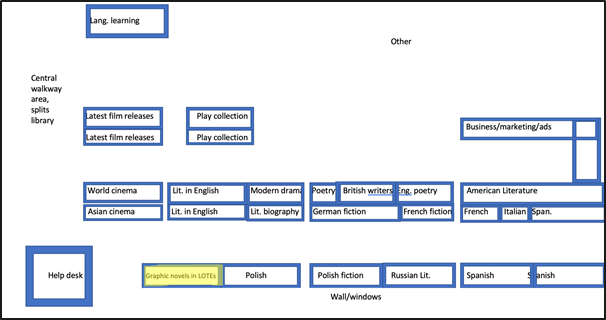
Conclusion
We found that Bristol Library’s Chinese book collection is mostly representative of the community, which is a great start. The main problem is that the landscape of the stock is currently preventing Chinese speakers’ physical access to Chinese books. The few books that are available are put ad hoc into shelves in other language sections, which may restrict Bristol Library’s ability to forward a community-focused, culturally-inclusive identity.
Case Study 2: Coventry Central Library
Coventry’s Central Library is based in Coventry Market, located in the city centre as part of an essential public space for its growing community. Coventry City Centre’s website highlights the wide range of multilingual books provided by the library. We chose to look into their collection of Chinese books as we did for our case studies in Knox and Bristol.
Census vs collection
The Chinese language collection is located in the World Books section. It consists of five bookcases with just over 2,000 titles, making up 1.22% of Coventry Central Library’s catalogue. The Library’s collection of Chinese books seem to over-represent the Chinese community in Coventry based on 2011 census data (NHS Coventry and Rugby Clinical Commissioning Group, 2011) (see table below.)
However, more recent data shows that the amount of Chinese students entering higher education in the UK has significantly grown since 2011/2012. Higher Education Statistics Agency (2021) found that in 2019/2020 there was double the amount of first-year Chinese higher education students studying in the UK than in 2011/2012. This increase of Chinese students living across the UK suggests that the population of Chinese people in Coventry has significantly increased from the population recorded in 2011. Our initial impression was that the Chinese language collection over-represents the Chinese-speaking population in Coventry. However, based on the evidence of the growing population and the fact that the last census was ten years ago, this may not be the case.
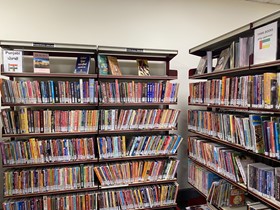
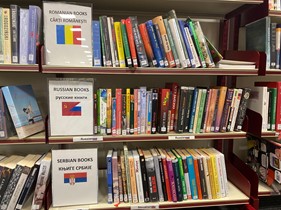
Similar to our case study in Bristol, the book collection of Coventry Central Library under-represents the population of Polish and Panjabi speakers by a large extent, despite the two being the largest categories of foreign languages spoken in Coventry.

Stock positioning
The World Book section can be found at the back of the second floor of Coventry Central Library, next to a staircase and the computer area—more accessible in comparison to Bristol’s current situation. Although the Library lacked multilingual signage guiding people to the World Book section, there was good use of dual-lingual signage dividing sections of books into different languages. Like our other case studies, the number of books published in Traditional Chinese and Simplified Chinese remained unclear. However, the books were divided into genres even though there was no signage for this. The library categorises both writing systems under the same section, identified by two signs displaying “Chinese Books.” This led us to believe that there is a lack of research into differentiating users of the two writing systems.

Conclusion
The Coventry Central Library’s Chinese language collection is representative of the Chinese community in Coventry based on 2011 census data. The Library’s lack of representation for speakers of other widely spoken languages also shows that this representation can only be applied to languages on a case-by-case basis. One explanation we found for their efforts of representing Chinese communities, is the ongoing population growth in the UK based on more recent research beyond the 2011 census, including the increase of higher education students from China living in the UK. We think that there is potential for more research to be done in this area following the publication of the 2021 census in the UK.
Case Study 3: Knox Library
The Knox Library in Knox City Shopping Centre is a community hub for the Knox Local Government Area (LGA). Being the central library for 12 eastern suburbs, Knox was an exciting Library for us to visit as linguistic researchers. Like our other two library case studies, Knox’s collection included a dedicated Chinese language section.
Census vs collection
In 2016, Mandarin and Cantonese had the highest percentages of speakers for a language other than English in the Knox LGA (8.3% total). Nearly 2% of Knox Library’s resources were in Chinese languages. But in comparison to the 8.3% of the population of Knox in 2016 that were Chinese language speakers, this is not enough to be truly representative.
Other LOTEs which had a population of speakers in the Knox area - such as Sinhalese and Greek—had no titles available. There were four Italian books available - all children’s books - as opposed to the 1.2% of the community who were Italian speakers.
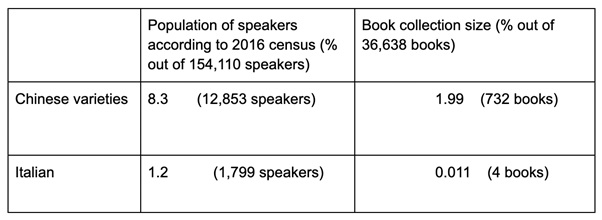
Position of the stock
The Chinese language collection took up three bookcases or 12 shelves total and was in the back corner of Knox library. Despite this positioning, people did visit this back corner to find the daily newspapers located next to the Chinese language section. Tables and chairs were also available to use by patrons in front of the Chinese language section, resulting in more traffic by the area. The Chinese collection also held the only instance of multilingual signage in the library: the Chinese collection had a sign with simplified Chinese characters.
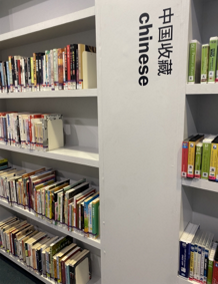
Variation
The collection was labelled as ‘Chinese’ and there was no separation of genres within the collection, including fiction from nonfiction - unlike with English language books.
A staff member told us an important piece of information: that the Chinese language collection at Knox is small and the books there are old. So, even though the collection is present and was the largest in a language other than English, the staff member led us to believe that this collection was not actually current or popular amongst the community. Instead, the staff member directed us to the Eastern Regional Libraries online database where they have over 25,000 digital e-books available in Chinese languages. This online database is being continually updated with new titles.
Conclusion
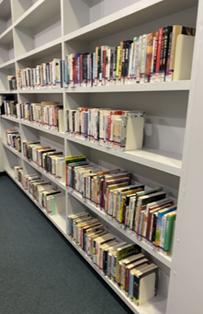
The collection available appears to be representative of the local community based on the census results - Chinese is the second largest language group in the Knox area and Chinese languages are the second most represented languages in the library.
Still, it is important to consider that the library staff member seemed to think the collection was inadequate and the books were old and not often borrowed. It is also worth noting that the collection is relatively small. Like Bristol and Coventry libraries, although the collection may seem somewhat representative based on the statistics, the reality is that it is not curated in a way which allows it to be fully useful, current, and accessible to the community.
What did we learn?
If we simply compare the amount of Chinese-language stock with census data, we might think that it is representative of the size and presumable interest of the Chinese communities. However, just like in Musgrave and colleagues’ (2019) work, the findings from our interviews and photos showed a more nuanced situation than it initially seemed. In fact, after combining the findings from our various data sources we think that all three of the libraries we studied could improve their resources and collections for the Chinese-speaking communities in the respective areas.
Instead, the libraries seem to be characterised by a rather monolingual mindset: English language collections are given a much higher importance than library items in other languages. Just consider how foreign language books are grouped together without displays or differentiation according to genre. Our conversations with library staff suggest that staff think their services and collections in Chinese languages could be improved. Despite the image of libraries as a community-focused cultural hub where a certain level of effort to provide an atmosphere of representation and inclusion would be expected, not enough is being done in Knox, Coventry, and Bristol libraries to cater to their potential Chinese-speaking customer base.
What do we recommend?
We believe that libraries have a responsibility to examine the monolingual perspective that shows in their collections. They also need to re-evaluate their role in the local community as well as how they want and/or need to provide for it. We would like to make some practical recommendations (based on previous research and the specific issues in these libraries) which could help them increase the focus put on underrepresented groups. While we based our research on three specific locations, we believe that some of our recommendations may be applied on a larger scale to other institutions as well, in order to reach a higher level of cultural representation.
- Bristol Library needs to move their Chinese-language collections to an accessible spot in the library as soon as possible; if this is currently not possible, multilingual (Chinese and English) signs need to explain the situation.
- Foreign language collections should be grouped according to genre, just like library items in English. Not only will this improve the browsing experience and the service the libraries provide, but it will also show their acknowledgment of and consideration for their culturally and linguistically diverse customer base.
- Libraries should employ more multilingual staff representative of their local communities in order to improve communication with customers and strengthen the image of libraries as a place of inclusion (Creese & Blackledge, 2019).
- Libraries need to focus on reliable demographic data such as census data to guide their stock acquisitions, and simultaneously develop and enhance their outreach teams in order to collect well-backed and researched information on the communities’ interests.
- One particular positive of all three libraries was that they were part of a larger network of local libraries which enables them to share collections and limit overlap in stock and services. Hall’s 2010 study shows that this would expand their shared range of resources and allow them to better cater to all their customers’ needs and wishes.
So, what do we conclude from all this? We feel that while these libraries have made an effort to cater to their Chinese speaking communities, there is still more work to be done in the area to accommodate the growing Chinese communities in these cities. We recommend that similar research is done, but this time on a larger scale, including more locations, to examine and improve how public libraries can cater to their linguistically and culturally diverse communities. And maybe next time you go to your library, think about how they are caring for you.
Bibliography
Australian Bureau of Statistics. (2017) 2016 Census Quickstats. Retrieve from https://quickstats.censusdata.abs.gov.au/census_services/getproduct/census/2016/quickstat/LGA23670
Bristol City Council. (2020). Bristol City Council Library Strategy. Bristol: Bristol City Council. https://www.bristol.gov.uk/policies-plans-strategies/bristol-library-strategy
Bristol Open Data. (2011). Language list (2011 census). Retrieve from https://opendata.bristol.gov.uk/explore/dataset/language-list/information/
Coventry Libraries and Information Service. (2021). Local Database. Retrieve from https://librarycatalogue.coventry.gov.uk/iguana/www.main.cls?surl=CoventryLibrariesHomePage
Cox, E. & State Library of New South Wales (Eds.). (2000). A safe place to go: Libraries and social capital. Sydney, NSW, State Library of NSW.
Creese, A. & Blackledge, A. (2019). Translanguaging and public service encounters: language learning in the library. Modern Language Journal, 103(4), 800–814. https://doi.org/10.1177/0961000619874110
Davies, S. (2008). Taking stock: the future of our public library service. Unison. https://www.unison.org.uk/content/uploads/2013/06/On-line-Catalogue173013.pdf
Hall, M. (2011). Collaboration and co‐operation in Asian library resource collections: An example from Melbourne, Australia. Library management, 32(1/2), 98-110. https://doi.org/10.1108/01435121111102610
Higher Education Statistics Agency (HESA). (2021). Where do HE students come from? Retrieve from https://www.hesa.ac.uk/data-and-analysis/students/where-from#non-uk
Holdsworth, L. (2007). The use of displays in public libraries: The librarians’ viewpoint. Sheffield: The University of Sheffield.
Musgrave, S., Wright, S., Denison, T., & Willoughby, L. (2019). Managing multilingual collections: Insights from data analytics research. Journal of Librarianship and Information Science, 52(3), 853-863. https://doi.org/10.1177/0961000619874110
NHS Coventry and Rugby Clinical Commissioning Group. (2011). Office for National Statistics 2011 Census figures for Coventry City and Rugby Borough. Retrieve from https://www.coventryrugbyccg.nhs.uk/mf.ashx?ID=b4df9b3d-da84-4ee1-8f55-1d53ed898a2b
State Library of New South Wales. (2018). Benchmarking NSW public library services to multicultural communities. Sydney: State Library of New South Wales.
Multilingualism and Collective Identities in Melbourne’s Chinese Restaurants
Johanne Herland, Sonia Kulkarni and Marysia Popowska
Have you ever eaten at a Chinese restaurant and been befuddled by the menu? Have you skipped past a restaurant because it had no English—or do you prefer the authenticity?
We explored how Chinese restaurants use multilingualism to construct and market a collective identity, across three Melbourne suburbs. Chinese use correlated with the Chinese ethnic population, but also constructed a restaurant microculture. This has implications for government language policy, cultural relations, and the definition of collective identity.
When thinking about culture we often think about food. Like culture, food is linked to our sense of identity, particularly in areas with a history of migration, like Australia. To understand how language can construct collective identities in diverse cities, we studied the language in Chinese restaurants in three Melbournian suburbs with varying Chinese population densities.
Previous research
Studies of language displayed in public places (ie. linguistic landscapes) help us understand the effects of language use in a given environment, as it communicates underlying ideologies in the community. Sign writers can use public signage to create collective identities, which show allegiance to, or create distance from national, religious, or other groups. They may do so using language and their knowledge of the greater social context, as reflected in Spolsky and Cooper’s three conditions;
(1) Sign-writer’s skill condition: using a language the writer knows;
(2) Presumed reader condition: using a language expected to engage the audience;
(3) Symbolic language condition: using a language to express identity.
Linguistic landscape choices can wake nostalgia in minority communities by focusing on a minority language, or attract a broader audience by focusing on a majority language. A previous study of Box Hill, Melbourne found that English was preferred on monolingual signs, but Chinese was prominent on multilingual signs. They concluded that the suburb’s Chinese population maintains its linguistic practices rather than adapting to the majority language. Australia has a relatively flexible language policy in marketing, which gives sign writers the opportunity to construct their own collective identities.
Previous linguistic landscape studies have provided a good overview of the effects of linguistic choices in constructing collective identities. Many have focused on English as a global language. Still, little work has compared the role of Chinese language in creating collective identities in different parts of one city. This leads us to the research question:
How do Chinese restaurants use multilingualism to construct and market a collective identity across three Melbourne suburbs?
Methodology
We collected data from Chinese restaurants in three Melbourne suburbs with different Chinese population sizes: Box Hill, Glen Waverley and Brighton. We chose four restaurants per area, each located on main shopping streets.
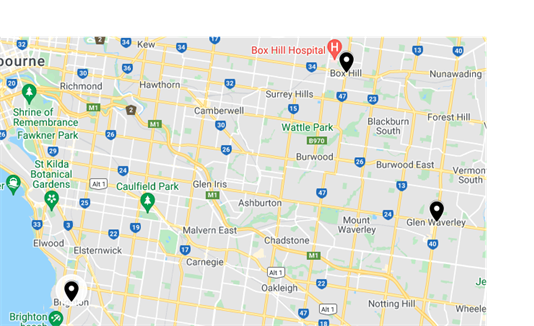
Figure 1: Suburb location
We used Backhaus’ definition that a sign is “any piece of text within a spatially definable frame”. Photos of bottom-up (unofficial) signage were collected, including menus, while top-down signage (official) was ignored. Additionally, we collected data from interviews and restaurants’ online presence. After examining the three suburbs, we looked more closely at Glen Waverley, the middle point regarding location and Chinese population size.
Results
We analyzed the signs based on three criteria: languages used, prominence on multilingual signs, and mutuality in translations (whether both languages communicate the same information).
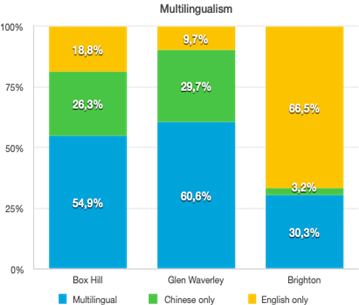
Figure 2: Multilingualism in three suburbs
The data for Box Hill and Glen Waverley did not differ much. Both prioritised Chinese in terms of prominence and non-mutual translations. In Brighton, English dominated in all three criteria.
Interviews and online presence supported these results: In all three suburbs, the staff were Chinese and bilingual, but the clientele varied by the area. In Box Hill, they were mostly Chinese; in Glen Waverley it varied greatly depending on the restaurant; and in Brighton they were mainly Caucasian.
This could explain the similar trend in language use on social media. Box Hill and Glen Waverley restaurants had a primarily Chinese social media presence, while Brighton used mainly English. However, Brighton restaurant managers said they still included Chinese “to give it an authentic Chinese vibe.”
|
|
Box Hill |
Glen Waverley |
Brighton |
|
Clientele |
Primarily Chinese |
Varied |
Primarily Caucasian |
|
Staff |
All Chinese staff Bilingual waitresses Often Chinese monolingual chefs or managers |
||
|
Restaurant social media |
Only in Chinese |
Primarily in Chinese |
Primarily in English |
|
Language(s) used by staff with clientele |
Chinese by default unless clients are Caucasian |
Varied by restaurant |
English by default unless clients prefer Chinese |
Figure 3: Qualitative data
We focused on two restaurants within Glen Waverley, one with the most English (China Bar) and one with the most Chinese (Kowloon Cafe).
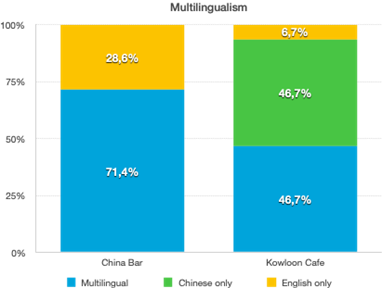
Figure 4: Multilingualism in China Bar & Kowloon Cafe
China Bar used predominantly English for communication, displaying no signs in Chinese only (illustrated by the first graph’s lack of green). This contrasts with Kowloon Cafe, where almost half the signs were only in Chinese and over 90% included some Chinese.

Figure 5: Prominence on signs in China Bar and Kowloon Cafe
The prominent language also varied significantly. Even when China Bar included Chinese, English was still dominant.
Qualitative data from interviews also support this trend. China Bar had a mixed target audience, while Kowloon Cafe focused on Chinese clientele. As a result, the former mainly used English to interact with customers and the latter Chinese, although both places accommodated speakers of the less-common language.
Discussion
Language is a marketing tool…
Language use may reflect the sign writer’s skill, as restaurant owners were either bilingual or monolingual Chinese, but this explanation does not account for the significant differences between suburbs.


 Figures 6, 7, 8: Name banners in Box Hill, Glen Waverley, and Brighton respectively
Figures 6, 7, 8: Name banners in Box Hill, Glen Waverley, and Brighton respectively
Differences may instead reflect the presumed reader condition (ie. target audience). For example, Brighton’s Dumpling Parlour placed English in large, capital letters on its banner, clearly conveying information to the 79% of Brighton residents who use English only at home. Glen Waverley’s Hong Kong Dim Sum also centralised English, but encircled it with Chinese product information. This non-mutual translation reflects the predominantly Chinese-speaking customer base while including a lingua franca for its multicultural audience. Box Hill’s Feast@556 also featured a non-mutually translated sign. The Chinese restaurant name [赤宴] (“Red Feast”) was large and central. The English alternative ‘Feast@556’ was in smaller, stylised writing to include the negligible audience of English-only speakers. For the majority Chinese speakers, this stylised red writing serves merely as an illustration of the Chinese name.
But why did restaurants in Box Hill and Glen Waverley have such similar signage? Despite Box Hill having 9% more Mandarin speakers, restaurant signs in both suburbs had similar Chinese use. This can be explained by the symbolic language condition.
The symbolic language condition suggests that language choice reflected ethnic identity instead of language ability (Box Hill and Glen Waverley had similar ethnic communities). Restaurants in both suburbs likely used signage to promise authenticity and nostalgia for those of Chinese ancestry. Even Brighton’s restaurants featured Chinese language to market their cultural identity, as revealed by interview data, despite having only 3.2% Chinese speakers. For instance, Dumpling Parlour placed Chinese writing on the left of its banner to be spotted first and deemed more important, but focused on aesthetics rather than intelligibility.
From the latter two conditions, we see that Chinese restaurants use language to market ethnic authenticity to either insiders (legible Chinese and decorative English) or outsiders (legible English and decorative Chinese).
… and can construct a microculture


Figure 9, 10: Kowloon Cafe
Not only did restaurant communication reflect suburb demographics, it also constructed opposing restaurant identities within a single suburb, as exemplified by Glen Waverley’s Kowloon Café and China Bar.[1] Kowloon Café marketed a specialised authenticity, excluding cultural and linguistic outsiders from gaining product information. Chinese was displayed prominently in a clear font at the top of its banner to draw the attention of Chinese speakers. Managers explained that the name refers to Hong Kong city “Kowloon,” known for its signature cafes with hearty meals and milk tea. This reference draws in customers familiar with the connoted products. We also looked at a small, temporary sign as an indication of the cafe’s primary target audience when forced to choose for economic reasons. On such temporary signs, Kowloon Café chose monolingual Chinese for its self-service instructions, leaving the occasional non-Chinese customer to ask for a translation.

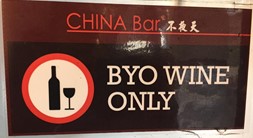
Figure 11, 12: China Bar
In contrast, China Bar used language to market to a multicultural demographic with a shared sense of modernity. English was included on the left of its banner in large letters, with capital ‘CHINA’ underlined in red font. By drawing the reader’s attention to the most stereotypical elements of Chinese culture (red for luck, ‘noodle and rice’) and explicitly stating that the restaurant is Chinese, China Bar has created a near caricature of Chinese culture. This prominence of English may contribute to a sense of modernity and globalism, creating accessibility for a multicultural customer base. Chinese was less prominent on the right in smaller font, but was clearly legible for Chinese readers. The restaurant's small, laminated sign included only English instructions to ‘BYO wine,” prioritising English as the lingua franca for economic reasons.
So what?
Ben Rafael (2009) defines collective identity as showing allegiance to, or creating distance from national, religious, or other groups, focusing on the clearly defined groups within a multicultural society. For example, Box Hill and Glen Waverley’s Kowloon Cafe defined community boundaries by country of origin.
We propose that this definition be revised to specify either a past or current cultural allegiance. For example, Brighton and Glen Waverley’s China Bar constructed their restaurant communities consistent with a multicultural Australian identity, based on a new, more assimilated culture, rather than one tightly connected to country of origin. The collective-identity principle may then be not only a label to describe non-assimilated social groups, but rather a measure of community boundaries within any multicultural society.
This variety of collective identity definitions may be facilitated by Australia’s flexible language policy. The only instruction is that marketing signage ‘be appropriate for … the audience and medium’. Other areas of language policy could emulate this freedom to take advantage of cultural wealth in domains other than advertising (for example, education).
Different levels of multilingualism in these three suburbs contribute to an overall multicultural society with clearly defined collective identities. The high maintenance of cultural identity and low contact could lead to separation of cultures within Box Hill and Glen Waverley. However, the inclusion of English welcomes outsiders, limiting the possible extent of cultural isolation. In Brighton, high contact could contribute to building an integrated society.
Final thoughts
Language takes part in constructing collective identities in Melbourne, not only through readers’ multilingualism, but also through associated cultural knowledge. The language variety we found reflects a flexible language policy within culturally diverse areas, allowing for shared cultural experiences. This flexibility could be echoed in other domains to increase cultural exchange.
Future studies should take a larger sample to reduce the margin of error and should conduct qualitative analysis (including customer interviews).
References
Australian Association of National Advertisers. (2021). AANA Code of Ethics [PDF], accessed 16 July 2021.
Australian Bureau of Statistics. (2016). Box Hill (Vic.)', 2016 Census QuickStats, accessed 13 July 2021.
Australian Bureau of Statistics. (2016). 'Brighton (Vic.)', 2016 Census QuickStats, accessed 13 July 2021.
Australian Bureau of Statistics. (2016). Glen Waverley (Vic.)', 2016 Census QuickStats, accessed 13 July 2021.
Backhaus, P. (2006). Multilingualism in Tokyo. International Journal of Multilingualism, 3(1), 52-66. DOI:10.1080/14790710608668385
Ben-Rafael, E. (2009). A Sociological Approach to the Study of Linguistic Landscapes. In E. Shohamy & D. Gorter (Eds.), Linguistic Landscape : Expanding the Scenery (pp. 40-54). New York: Routledge
Ben-Rafael, E., Shohamy, E., Amara, M. & Trumper-Hecht, N. (2006). Linguistic Landscape as Symbolic Construction of the Public Space: The Case of Israel. International Journal of Multilingualism. 3(1), 7-30. DOI: 10.1080/14790710608668383.
Berry, J. W. (2017). Theories and Models of Acculturation. In S. J. Schwartz & J. Uger (Eds.), The Oxford Handbook of Acculturation and Health (pp. 1-22). DOI: 10.1093/oxfordhb/9780190215217.013.2
Buckingham, L. (2019). Migration and ethnic diversity reflected in the linguistic landscape of Costa Rica’s Central Valley. Journal of Multilingual and Multicultural Development, 40(9), 759-773. DOI: 10.1080/01434632.2018.1557666
Cook, V. (2014). Meaning and material in the language of the street. Social Semiotics, 25(1), 81-109. DOI: 10.1080/10350330.2014.964025
Ichijo, A. & Ranta, R. (2016). Food, National Identity and Nationalism. London: Palgrave Macmillan. DOI: 10.1057/9781137483133
Jia Lou, J. (2012). Chinatown in Washington, DC: The bilingual landscape. World Englishes, 31(1), 34-47. DOI: 10.1111/j.1467-971x.2011.01740.x
Kress, G., & Van Leeuwen, T. (2006). Reading images (2nd ed.). Abingdon: Routledge.
Lee, J. S. (2019). Multilingual advertising in the linguistic landscape of Seoul. World Englishes, 38(3), 500-518. DOI: 10.1111/weng.12427
Leimgruber, J. R. E. (2020). Global multilingualism, local bilingualism, official monolingualism: the linguistic landscape of Montreal's St. Catherine Street. International Journal of Bilingual Education and Bilingualism, 23(6), 708-723, DOI: 10.1080/13670050.2017.1401974
Lipovsky, C. & Wang, W. (王玮). (2019). Wenzhou Restaurants in Paris’ Chinatowns. Journal of Chinese Overseas, 15(2), 202-233. DOI: 10.1163/17932548-12341402
Schmitt, B. H., & Pan, Y. (1994). Managing Corporate and Brand Identities in the Asia-Pacific Region. California Management Review, 36(4), 32–48. DOI: 10.2307/41165765
Shohamy, E. (2018). Linguistic Landscape after a Decade: An Overview of Themes, Debates and Future Directions. In M. Pütz & N. Mundt (Eds.), Expanding the Linguistic Landscape (pp.25-37). Bristol ; Buffalo: Multilingual Matters.
Spolsky, B. (2009). Prolegomena to a sociolinguistic theory of public signage. In E. Shohamy & D. Gorter (Eds.), Linguistic Landscape: Expanding the Scenery (pp. 25-39). New York: Routledge.
Tufi, S. (2013). Shared places, unshared identities: vernacular discourses and spatialised constructions of identity in the linguistic landscape of Trieste. Modern Italy, 18(4), 391-408. DOI: 10.1080/13532944.2013.802411
Tran, T. T. (2021). “Pho” as the Embodiment of Vietnamese National Identity in the Linguistic Landscape of a Western Canadian City. International Journal of Multilingualism, 18(1), 73–89, DOI: 10.1080/14790718.2019.1604713
Yao, X., & Gruba, P. (2020). A layered investigation of Chinese in the linguistic landscape: A case study of Box Hill, Melbourne. Australian Review of Applied Linguistics, 43(3), 302–336. DOI: 10.1075/aral.18049.yao
